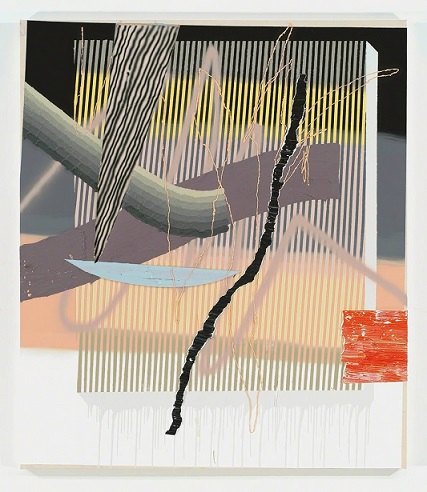정준모







Trudy Benson
Computer Painting, 2013
Horton Gallery
Today, Benson’s work has evolved to incorporate collage elements that are less explicitly tied to MS Paint. But the influence of digital painting programs remains. “I still use a lot of layers, and there's still that sense of a shallow depth,” she says. “There's still a really graphic quality.”
Similarly, Lee’s paintings incorporate the erratic lines and technicolor hues of MS Paint and other similar programs. He often draws on a tablet or in Photoshop when first visualizing a work, before physically translating them in the studio.
“That's become almost a primary way of thinking,” Lee says. “Even if I'm making a painting with real paint, my brain will go to a color slider first. Certain colors I can't actually make so I have to fake it by color relationships. For me, digital is a default mode.”

Austin Lee
WynnVeen, 2016
Postmasters Gallery
Scudder acknowledged this development on a broader scale, noting that digital tools have “fundamentally changed our understanding of drawing and painting by shifting the focus towards process and the abstract representation of pictures using information as opposed to material.” In his classes, he encourages students to develop their own programs rather than focusing on the commercially available software—the first time, he says, a digital painting course has done so.
Of course, young contemporary artists are not the only ones who use MS Paint. Nonagenarian Hal Lasko delighted the internet with his astonishingly complex digital paintings, while David O’Reilly achieved a measure of cult YouTube status for his Octocat Adventures. Scudder says one of his favorite MS Paint users is SHADOWBEARMUSEUM. “I’ve never seen anyone use the tool quite like that before,” he says, “but it’s just one star out of many in this universe that is the MS Paint user base.”
That following—both inside and outside the art world—was facilitated by the program’s simplicity. “I think the advantage it has over a lot of other drawing tools is that it's so easy to use,” says Benson. And unlike programs such as Photoshop, which have become increasingly complex from update to update, MS Paint remained practically static between 1995 and 2007.

Paint Brush types in Microsoft Paint in Windows 7, via Wikimedia Commons.
Perhaps more significant than its simplicity, however, was its ubiquity. For 32 years, MS Paint was packaged into each new update to the Windows operating system. Unlike MacPaint, which cost $195 when it was first released, MS Paint was free to anyone who purchased a computer from Microsoft.
“It's so accessible the way it is. It's barebones, but you can actually use it to do incredible things,” says Benson. “I think that's the best thing about it.”
—Abigail Cain
FAMILY SITE
copyright © 2012 KIM DALJIN ART RESEARCH AND CONSULTING. All Rights reserved
이 페이지는 서울아트가이드에서 제공됩니다. This page provided by Seoul Art Guide.
다음 브라우져 에서 최적화 되어있습니다. This page optimized for these browsers. over IE 8, Chrome, FireFox, Safari